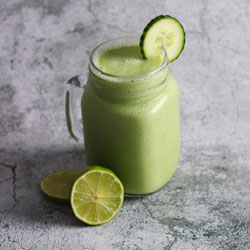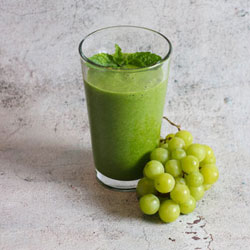
How to make a smoothie seems like a trivial topic, considering that making one is so simple, right?
Well, yes and no.
Yes, because there are numerous smoothie recipes online that you can simply follow. Not to mention, it’s usually a “place all the ingredients into the blender, and blend.”
However, the no side of the story is when making your own smoothie, there are some guidelines that you should follow. It may not be mandatory, but it’ll make your smoothie a lot better.
So, without further ado, let’s kick things off with the first step.
Step 1: Choose a liquid base

There are several choices for the liquid base.
- Dairy milk
- Non-dairy milk (soy milk, oat milk, almond milk, etc.)
- Water
- Fruit juice
Here’s the deal:
Even though fruit juices are part of the choices for the liquid base, I don’t recommend them nearly as much. The reason being is that fruit juices are generally sweet.
In other words, if you’re going to use a sweet fruit such as a banana along with fruit juice, you’ll end up with an indulgent dessert instead of a healthy smoothie.
That being said, if you utilize fruit juice as your liquid base, simply adjust the number of sweet fruits you’ll use accordingly.
Pro tip: You can use half-half of the liquid base, like half milk, half water.
Here’s more:
Depending on your blender, you may need to add more liquid than necessary. For instance, in low-powered blenders such as Magic Bullet or Hamilton Beach Personal Blender, the ratio should be about 60% liquid and 40% soft ingredients.
By the way, you should always start by adding the liquid base, then soft fruits or veggies, and the frozen items should always be last.
Step 2: Choose your favorite fruit (the natural sweetener)
There are lots and lots of fruit choices out there. The most common is probably banana. In fact, most of my recipes include a banana. Obviously, you can choose your favorite fruit.
Ideally, there should be at least 2 types of fruits. It can be any combination you like. Some of my favorites are strawberry banana, pineapple mango, and avocado cucumber.

Oh, and of course, make sure that the fruit you’ll use is ripe.
Pro tip: If your fruits are already ripe but you won’t be able to use them right away, freeze them for future smoothies.
If you want a cold drink, it’s ideal to use frozen fruits. By doing so, you don’t need to use ice which might dilute the flavor of your smoothie. That’s a win-win right there.
However, ice is still helpful for some smoothie recipes. For instance, if you’ve used too many sweet ingredients, you can try adding ice (or water) to balance out the flavor a bit.
For a tangy flavor, you can also add lemon or lime juice. Not to mention, this will balance out the overall taste and texture of your smoothie if you’ve used fruit thickeners such as avocado and banana.
Here’s the deal:
Fruits are already naturally sweet. In that case, I don’t recommend using other sweeteners such as honey, maple syrup, or dates, as your smoothie will end up as a super sweet dessert instead.
Step 3: Add vegetables to your smoothie
Suppose you only want to make a fruit smoothie. In that case, you can skip this step.
Here’s the thing:

Adding vegetables to your smoothie is excellent. For instance, if you don’t like the flavor of some greens, you can simply blend it in a smoothie, and chances are you won’t even taste them. Yet, you’ll get the nutritional benefits of the said vegetables.
This is especially helpful for kids who are picky with their veggies.
These are four of my usual choices:
- Spinach
- Kale
- Romaine lettuce
- Carrots
Ideally, the ratio of fruit to vegetables is 2:1. Of course, that’s not a “rule” per se. It can be 3:2, or even 1:1, depending on the fruits and veggies that you’ll use.
Pro tip: Make sure to rotate your greens. For instance, when you used spinach last week, try other greens such as kale, romaine, or maybe even broccoli for next week.
Step 4: [Add-ons] Utilize herbs and spices, thickeners, or superfoods
This step is often overlooked. However, when you use particular add-ons, your recipe will be so much better compared to a regular one.
For herbs and spices, it doesn’t have to be complex like cooking. What I mean is that smoothies don’t necessarily need to have plenty of spices. But, it can liven up the recipe.

For instance, the mint from Hint of Mint Smoothie blends so well with pineapple. Another fantastic example is the Spring Green Smoothie’s 1 cup of parsley which lifts up the overall flavor of the smoothie.
With that said, the possibilities with herbs and spices are simply endless. And we’re not even done with the add ons.
As for the thickeners, there are numerous choices. Earlier, in the fruit section, there was already avocado and banana. Other options include nut butter, tofu, greek yogurt, and of course, chia seeds.
If your recipe doesn’t include banana or avocado, you can use the thickeners to achieve a creamier drink.
Now:
Chia seeds are also part of the superfoods—which will be healthy add-ons to your smoothie (apart from the veggies). Other than chia, there are also kombucha, cacao, matcha, flax seeds, kefir, goji berries, and acai.
Final Thoughts
Apart from all that, there’s one crucial variable you need to consider—the blender itself.
Sure, any blender is technically a smoothie maker. However, if you want to create an incredibly smooth smoothie without the chewy texture, you need a high-performance blender.
Click here for the Best High Power Blenders (#2 is budget-friendly) →

